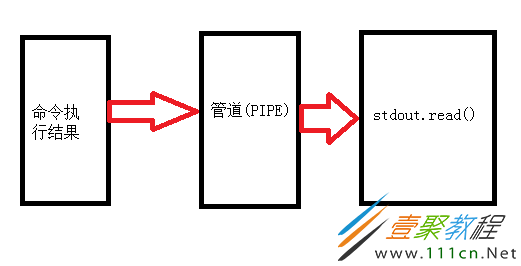一、subprocess以及常用的封装函数
运行python的时候,我们都是在创建并运行一个进程。像Linux进程那样,一个进程可以fork一个子进程,并让这个子进程exec另外一个程序。在Python中,我们通过标准库中的subprocess包来fork一个子进程,并运行一个外部的程序。
subprocess包中定义有数个创建子进程的函数,这些函数分别以不同的方式创建子进程,所以我们可以根据需要来从中选取一个使用。另外subprocess还提供了一些管理标准流(standard stream)和管道(pipe)的工具,从而在进程间使用文本通信。
subprocess.call()
父进程等待子进程完成
返回退出信息(returncode,相当于Linux exit code)
subprocess.check_call()
父进程等待子进程完成
返回0
检查退出信息,如果returncode不为0,则举出错误subprocess.CalledProcessError,该对象包含有returncode属性,可用try…except…来检查
subprocess.check_output()
父进程等待子进程完成
返回子进程向标准输出的输出结果
检查退出信息,如果returncode不为0,则举出错误subprocess.CalledProcessError,该对象包含有returncode属性和output属性,output属性为标准输出的输出结果,可用try…except…来检查。
这三个函数的使用方法相类似,下面来以subprocess.call()举例说明:
>>> retcode = subprocess.call([“ls”, “-l”])
#和shell中命令ls -a显示结果一样
>>> print retcode
0
将程序名(ls)和所带的参数(-l)一起放在一个表中传递给subprocess.call()
shell默认为False,在Linux下,shell=False时, Popen调用os.execvp()执行args指定的程序;shell=True时,如果args是字符串,Popen直接调用系统的Shell来执行args指定的程序,如果args是一个序列,则args的第一项是定义程序命令字符串,其它项是调用系统Shell时的附加参数。
上面例子也可以写成如下:
在Windows下,不论shell的值如何,Popen调用CreateProcess()执行args指定的外部程序。如果args是一个序列,则先用list2cmdline()转化为字符串,但需要注意的是,并不是MS Windows下所有的程序都可以用list2cmdline来转化为命令行字符串。
subprocess.Popen()
实际上,上面的几个函数都是基于Popen()的封装(wrapper)。这些封装的目的在于让我们容易使用子进程。当我们想要更个性化我们的需求的时候,就要转向Popen类,该类生成的对象用来代表子进程。
与上面的封装不同,Popen对象创建后,主程序不会自动等待子进程完成。我们必须调用对象的wait()方法,父进程才会等待 (也就是阻塞block),举例:
>>> child = subprocess.Popen([‘ping’,’-c’,’4′,’blog.linuxeye.com’])
>>> print ‘parent process’
从运行结果中看到,父进程在开启子进程之后并没有等待child的完成,而是直接运行print。
对比等待的情况:
>>> child = subprocess.Popen(‘ping -c4 blog.linuxeye.com’,shell=True)
>>> child.wait()
>>> print ‘parent process’
从运行结果中看到,父进程在开启子进程之后并等待child的完成后,再运行print。
此外,你还可以在父进程中对子进程进行其它操作,比如我们上面例子中的child对象:代码如下:
child.kill() # 终止子进程
child.send_signal() # 向子进程发送信号
child.terminate() # 终止子进程
子进程的PID存储在child.pid
二、子进程的文本流控制
子进程的标准输入、标准输出和标准错误如下属性分别表示:
child.stdout
child.stderr
可以在Popen()建立子进程的时候改变标准输入、标准输出和标准错误,并可以利用subprocess.PIPE将多个子进程的输入和输出连接在一起,构成管道(pipe),如下2个例子:
>>> child1 = subprocess.Popen([“ls”,”-l”], stdout=subprocess.PIPE)
>>> print child1.stdout.read(),
#或者child1.communicate()
>>> import subprocess
>>> child1 = subprocess.Popen([“cat”,”/etc/passwd”], stdout=subprocess.PIPE)
>>> child2 = subprocess.Popen([“grep”,”0:0″],stdin=child1.stdout, stdout=subprocess.PIPE)
>>> out = child2.communicate()
subprocess.PIPE实际上为文本流提供一个缓存区。child1的stdout将文本输出到缓存区,随后child2的stdin从该PIPE中将文本读取走。child2的输出文本也被存放在PIPE中,直到communicate()方法从PIPE中读取出PIPE中的文本。
注意:communicate()是Popen对象的一个方法,该方法会阻塞父进程,直到子进程完成
subprocess用来替换多个旧模块和函数:
- os.system
- os.spawn*
- os.popen*
- popen2.*
- commands.*
运行python的时候,我们都是在创建并运行一个进程,linux中一个进程可以fork一个子进程,并让这个子进程exec另外一个程序。在python中,我们通过标准库中的subprocess包来fork一个子进程,并且运行一个外部的程序。subprocess包中定义有数个创建子进程的函数,这些函数分别以不同的方式创建子进程,所欲我们可以根据需要来从中选取一个使用。另外subprocess还提供了一些管理标准流(standard stream)和管道(pipe)的工具,从而在进程间使用文本通信。
二、旧有模块的使用
Python subprocess模块功能与常见用法实例详解1.os.system()
执行操作系统的命令,将结果输出到屏幕,只返回命令执行状态(0:成功,非 0 : 失败)
|
1
2
3
4
5
6
7
8
9
10
11
12
13
|
import os>>> a = os.system("df -Th")Filesystem Type Size Used Avail Use% Mounted on/dev/sda3 ext4 1.8T 436G 1.3T 26% /tmpfs tmpfs 16G 0 16G 0% /dev/shm/dev/sda1 ext4 190M 118M 63M 66% /boot>>> a0 # 0 表示执行成功# 执行错误的命令>>> res = os.system("list")sh: list: command not found>>> res32512 # 返回非 0 表示执行错误 |
Python subprocess模块功能与常见用法实例详解2. os.popen()
执行操作系统的命令,会将结果保存在内存当中,可以用read()方法读取出来
|
1
2
3
4
5
6
7
8
9
10
11
12
13
14
15
16
17
|
import os>>> res = os.popen("ls -l")# 将结果保存到内存中>>> print res<open file="" 'ls="" -l',="" mode="" 'r'="" at="" 0x7f02d249c390=""># 用read()读取内容>>> print res.read()total 267508-rw-r--r-- 1 root root 260968 Jan 27 2016 AliIM.exe-rw-------. 1 root root 1047 May 23 2016 anaconda-ks.cfg-rw-r--r-- 1 root root 9130958 Nov 18 2015 apache-tomcat-8.0.28.tar.gz-rw-r--r-- 1 root root 0 Oct 31 2016 badblocks.logdrwxr-xr-x 5 root root 4096 Jul 27 2016 certs-builddrwxr-xr-x 2 root root 4096 Jul 5 16:54 Desktop-rw-r--r-- 1 root root 2462 Apr 20 11:50 Face_24px.ico</open> |
三、subprocess模块
Python subprocess模块功能与常见用法实例详解1、subprocess.run()
|
1
2
3
4
5
6
7
8
9
10
11
12
13
|
>>> import subprocess# python 解析则传入命令的每个参数的列表>>> subprocess.run(["df","-h"])Filesystem Size Used Avail Use% Mounted on/dev/mapper/VolGroup-LogVol00 289G 70G 204G 26% /tmpfs 64G 0 64G 0% /dev/shm/dev/sda1 283M 27M 241M 11% /bootCompletedProcess(args=['df', '-h'], returncode=0)# 需要交给Linux shell自己解析,则:传入命令字符串,shell=True>>> subprocess.run("df -h|grep /dev/sda1",shell=True)/dev/sda1 283M 27M 241M 11% /bootCompletedProcess(args='df -h|grep /dev/sda1', returncode=0) |
Python subprocess模块功能与常见用法实例详解2、subprocess.call()
执行命令,返回命令的结果和执行状态,0或者非0
|
1
2
3
4
5
6
7
8
9
10
|
>>> res = subprocess.call(["ls","-l"])总用量 28-rw-r--r-- 1 root root 0 6月 16 10:28 1drwxr-xr-x 2 root root 4096 6月 22 17:48 _1748-rw-------. 1 root root 1264 4月 28 20:51 anaconda-ks.cfgdrwxr-xr-x 2 root root 4096 5月 25 14:45 monitor-rw-r--r-- 1 root root 13160 5月 9 13:36 npm-debug.log# 命令执行状态>>> res0 |
Python subprocess模块功能与常见用法实例详解3、subprocess.check_call()
执行命令,返回结果和状态,正常为0 ,执行错误则抛出异常
|
1
2
3
4
5
6
7
8
9
10
11
12
13
14
15
16
17
18
19
20
21
22
|
>>> subprocess.check_call(["ls","-l"])总用量 28-rw-r--r-- 1 root root 0 6月 16 10:28 1drwxr-xr-x 2 root root 4096 6月 22 17:48 _1748-rw-------. 1 root root 1264 4月 28 20:51 anaconda-ks.cfgdrwxr-xr-x 2 root root 4096 5月 25 14:45 monitor-rw-r--r-- 1 root root 13160 5月 9 13:36 npm-debug.log0>>> subprocess.check_call(["lm","-l"])Traceback (most recent call last): File "<stdin>", line 1, in <module> File "/usr/lib64/python2.7/subprocess.py", line 537, in check_call retcode = call(*popenargs, **kwargs) File "/usr/lib64/python2.7/subprocess.py", line 524, in call return Popen(*popenargs, **kwargs).wait() File "/usr/lib64/python2.7/subprocess.py", line 711, in __init__ errread, errwrite) File "/usr/lib64/python2.7/subprocess.py", line 1327, in _execute_child raise child_exceptionOSError: [Errno 2] No such file or directory</module></stdin> |
Python subprocess模块功能与常见用法实例详解4、subprocess.getstatusoutput()
接受字符串形式的命令,返回 一个元组形式的结果,第一个元素是命令执行状态,第二个为执行结果
|
1
2
3
4
5
6
|
#执行正确>>> subprocess.getstatusoutput('pwd')(0, '/root')#执行错误>>> subprocess.getstatusoutput('pd')(127, '/bin/sh: pd: command not found') |
Python subprocess模块功能与常见用法实例详解5、subprocess.getoutput()
接受字符串形式的命令,放回执行结果
|
1
2
|
>>> subprocess.getoutput('pwd')'/root' |
Python subprocess模块功能与常见用法实例详解6、subprocess.check_output()
执行命令,返回执行的结果,而不是打印
|
1
2
3
|
>>> res = subprocess.check_output("pwd")>>> resb'/root\n' # 结果以字节形式返回 |
四、subprocess.Popen()
其实以上subprocess使用的方法,都是对subprocess.Popen的封装,下面我们就来看看这个Popen方法。
Python subprocess模块功能与常见用法实例详解1、stdout
标准输出
|
1
2
3
4
|
>>> res = subprocess.Popen("ls /tmp/yum.log", shell=True, stdout=subprocess.PIPE) # 使用管道>>> res.stdout.read() # 标准输出b'/tmp/yum.log\n'res.stdout.close() # 关闭 |
Python subprocess模块功能与常见用法实例详解2、stderr
标准错误
|
1
2
3
4
5
6
7
8
|
>>> import subprocess>>> res = subprocess.Popen("lm -l",shell=True,stdout=subprocess.PIPE,stderr=subprocess.PIPE)# 标准输出为空>>> res.stdout.read()b''#标准错误中有错误信息>>> res.stderr.read()b'/bin/sh: lm: command not found\n' |
注意:上面的提到的标准输出都为啥都需要等于subprocess.PIPE,这个又是啥呢?原来这个是一个管道,这个需要画一个图来解释一下:
Python subprocess模块功能与常见用法实例详解4、poll()
定时检查命令有没有执行完毕,执行完毕后返回执行结果的状态,没有执行完毕返回None
|
1
2
3
4
5
6
7
|
>>> res = subprocess.Popen("sleep 10;echo 'hello'",shell=True,stdout=subprocess.PIPE,stderr=subprocess.PIPE)>>> print(res.poll())None>>> print(res.poll())None>>> print(res.poll())0 |
Python subprocess模块功能与常见用法实例详解5、wait()
等待命令执行完成,并且返回结果状态
|
1
2
3
4
|
>>> obj = subprocess.Popen("sleep 10;echo 'hello'",shell=True,stdout=subprocess.PIPE,stderr=subprocess.PIPE)>>> obj.wait()# 中间会一直等待0 |
Python subprocess模块功能与常见用法实例详解6、terminate()
结束进程
|
1
2
3
4
5
|
import subprocess>>> res = subprocess.Popen("sleep 20;echo 'hello'",shell=True,stdout=subprocess.PIPE,stderr=subprocess.PIPE)>>> res.terminate() # 结束进程>>> res.stdout.read()b'' |
Python subprocess模块功能与常见用法实例详解7、pid
获取当前执行子shell的程序的进程号
|
1
2
3
4
|
import subprocess>>> res = subprocess.Popen("sleep 5;echo 'hello'",shell=True,stdout=subprocess.PIPE,stderr=subprocess.PIPE)>>> res.pid # 获取这个linux shell 的 进程号2778 |
今天的文章python3 subprocess模块_python threading模块分享到此就结束了,感谢您的阅读,如果确实帮到您,您可以动动手指转发给其他人。
版权声明:本文内容由互联网用户自发贡献,该文观点仅代表作者本人。本站仅提供信息存储空间服务,不拥有所有权,不承担相关法律责任。如发现本站有涉嫌侵权/违法违规的内容, 请发送邮件至 举报,一经查实,本站将立刻删除。
如需转载请保留出处:https://bianchenghao.cn/52478.html

